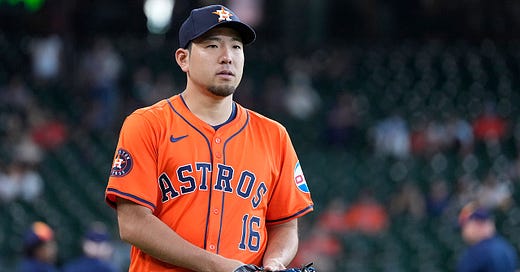Yusei Kikuchi Hits the Open Market as the Best Version of Himself
He ranks 5th in K-BB% over the past two seasons
My baseball group chat recently started our annual “free agency threads,” where we conduct deep dives into players about to hit the open market.
This exercise always gets me thinking about various factors related to each player—their value, how the market will perceive them, and which teams are the best fits. This year, I’ve decided to use the research I’ve already done to turn it into articles, too.
Please note that we like to bounce between stars, scrubs, and everything in between, so the writeups won’t be released in any particular order.
Yusei Kikuchi, LHP, Age: 33
Kikuchi enters free agency after his age-33 season, but he’s doing so at a good time—fresh off his best big league campaign and with a two-year sample of performing at a level above what he initially showed.
This is best illustrated by his yearly strikeout minus walk rates:
2019: 9.2%
2020: 13.9%
2021: 15.2%
2022: 14.5%
2023: 19%
2024: 22%
Kikuchi bottomed out in 2022 with a third percentile BB% and a disastrous 5.19 ERA.
2023 is when he got the walks under control, which made all the difference for him.
In ‘22, Kikuchi relied on his four-seamer and slider over 80% of the time. He was predictable, and worse, he couldn’t locate:
In 2023, not only did he stop living so heavily in the heart of the plate, but his pitch locations became much tighter overall:
2023 was also when he introduced a curve, giving him a balanced, four-pitch arsenal.
Earlier in his career, Kikuchi utilized a cutter. While multiple fastballs are a plus, Kikuchi lacked command, and his overall arsenal didn’t fit well together.
So, he ditched the cutter, eventually added the curve, and developed a second high-velo pitch by increasing how hard he threw his slider:
This package has worked wonders for Kikuchi. Among qualified starters over the past two seasons, he ranks 5th in K-BB%. Even if we lower the innings threshold to 250, Kikuchi still places in the top 10.
Generating strikeouts and limiting walks are a pitcher's most essential skills. However, Kikuchi still had roughly a league-average ERA due to an inability to restrict homers and hits. In other words, the batted ball metrics have never been ideal.
Over the past two years, just three qualified starters have allowed a higher barrel rate. Only four have given up a higher BABIP, and only six have a worse HR/9.
Typically, these can be viewed as “luck-based” metrics, but that’s relative to a player’s established baseline. Given that Kikuchi has always struggled with homers and hits, it shouldn’t be seen as a given that positive regression is coming. It’s always possible that everything breaks right for a year or two — his K-BB% remains elite, and he runs purely with everything else. That’s the upside case as he enters free agency.
It was just a 10-start sample, but Kikuchi adjusted his pitch mix upon arriving in Houston at last summer’s trade deadline—spinning more sliders while scaling back his four-seamer usage. The results were tremendous:
Kikuchi even increased his grounder rate and had some BABIP luck with Houston. Opposing hitters might eventually adjust to his new slider-fastball plan if he sticks with it to begin 2025, so the Astros version of Kikuchi shouldn’t be treated as the new normal.
Whereas most position players only have a few “true” fits in free agency, basically every team can use more pitching. Kikuchi’s market will be widened since he’s only expected to land a 3-year deal and comes without a qualifying offer (unlike Nick Pivetta, who possesses similar K-BB% results but also has a homer problem).
The teams that first came to mind were the Mets, Orioles, Red Sox, Astros, and Padres. On Tuesday morning, ESPN’s Jeff Passan also mentioned the Cubs, Angels, Dodgers, and Blue Jays as potential fits.
For fantasy purposes, landing in a home park that neutralizes homers is the most important thing to monitor.
I predict Kikuchi will wind up with the Mets (!) on a 3-year, $66 million contract. New York has the necessary budget to give him a slightly higher AAV if his market gets competitive, and signing Kikuchi while recouping a draft pick or two (should Sean Manaea or Luis Severino sign elsewhere) is some excellent business.










